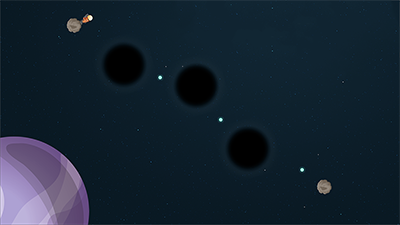History
A Long Way Home began development back in December of 2010. In it's original form, you simply jumped from asteroid to asteroid trying to reach a goal. Physics played a very minor role, if any, in the players movement. The asteroids did not spin, and there was nothing to collect. I realized pretty quick that it was a little boring.


The second iteration of the game included spinning asteroids, portals, and dark matter. It also was played as a top down type game, which just didn't feel right. The player could only move with the rotation of the asteroid, which was too slow. There were some other ideas that ended on the chopping block as well. The game's playable area exteded beyond the size of the screen, allowing you to pinch to zoom out and see everything, but that was too difficult, it was almost impossible to lineup a jump.
The 'final' form of A Long Way Home was it's best. I had dropped the camera tricks, swiched back to a profile view, and combined the spinning asteroids with the player walking. Physics and Gravity's role in how you play was increased, most notibly in the later stages of the game where you must use black hole's gravational pull to navigate a level. The introduction of the wrist computer brought some much needed dialog / story progression to the game. It was difficult to explain what you were doing and why you were doing it, but Eddie filled that role nicely. He is there to get you started, and every time a new hazard is introduced he helps you figure it out. The game was released for the iPad and was immediatly featured by Apple. Over the next few years updates rolled out, fixing bugs, supporting new systems and adding new features.


Last October I submitted the game for Steam's Greenlight. To make sure this wasn't just another mobile port, I redesigned the game from the ground up. Every single piece of artwork in the game was recreated at 4x the original resolution. The entire menu system was redesigned. The game was converted from a 4:3 ratio to widescreen (this was no small feat). A demo was created to show people this was not just a quick port, but also to give people an idea of what the game was about. Once everyone had a chance to try it, most people enjoyed it. The game was built to run on Windows / Mac and Linux, and supports Steam Achievements and trading cards and more.
I hope you enjoy it.